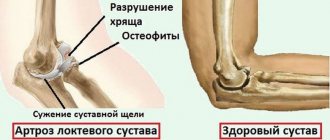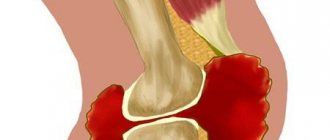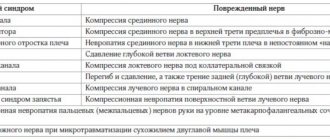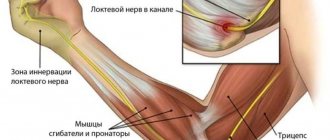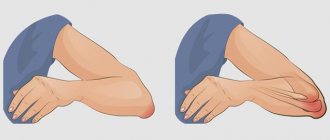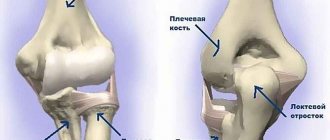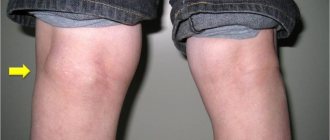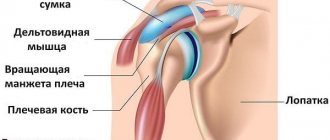Your orthopedist
Everything about the musculoskeletal system on one site: Back, Joints, Bones and more
Home › Joint diseases › Synovitis › Synovitis of the elbow joint: how to “improve” your arm?
The elbow is enlarged and hurts: what kind of disease is this?
Synovitis is an inflammation of the synovial membrane (the internal capsule of the joint), which is limited to its limits. The disease leads to disruption of bone articulation.
Synovitis of the elbow joint at the beginning of its onset can be almost painless, so patients do not rush to see a doctor, thereby wasting valuable time and allowing the pathology to progress.
- A little anatomy
- Reasons for the development of the disease
- How does the disease manifest?
- Basic diagnostic methods
- Modern methods of treatment Joint puncture
- Elbow fixation
- Drug treatment
- Surgery
- Exercise therapy and physiotherapy
What is synovitis of the elbow joint?
The complex elbow joint consists of three small joints that are located in a common joint capsule. The inner membrane lining the surface of the capsule is called synovial, the main function of which is the production of joint fluid.
An inflammatory reaction involving the synovium of the elbow is called synovitis. Pain with limited movement against the background of an enlarged deformed elbow is a characteristic symptom of inflammation of the inner surface of the joint capsule. With synovitis, the voids in the joint are filled with effusion of various compositions. The synthesis of synovial fluid decreases sharply, after which the tissues experience oxygen starvation and nutrient deficiency.
Causes
A common cause of pain when moving the arm is synovitis. Inflammation of the inner lining of the joint capsule develops as a complication after traumatic injuries, pathologies of a chronic and infectious nature. To cure a disease, symptomatic therapy alone is not enough; procedures must be aimed at eliminating the cause of the inflammation.
The development of inflammation due to synovitis is always preceded by damage or irritation of the superficial villous layer of the synovium. The cause may be microtrauma or the introduction of pathogens. The response is manifested by swelling and the appearance of exudate, which fills the entire internal space of the joint capsule.
The main causes of the inflammatory reaction of synovitis include:
- elbow injuries: bruises, sprains, ligament tears, fractures;
- diseases associated with metabolic disorders: gout;
- when exposed to an infectious pathogen: tuberculosis, tonsillitis in the chronic stage;
- parasitic infestations: brucellosis;
- processes associated with autoimmune disorders: rheumatism;
- degenerative changes in joints: osteoarthritis, ankylosing spondylitis;
- allergenic factor: allergic arthritis, food allergies, bronchial asthma;
- sexually transmitted diseases: syphilis;
- pathologies of the internal secretion organs: diabetes mellitus, hyperthyroidism;
- inherited diseases: hemophilia.
Classification
Synovitis of the elbow joint varies according to several criteria. Considering the time course of the pathology, in orthopedic practice acute and chronic inflammation are distinguished. Sudden pain in the elbow, swelling of the joint, inability to bend or straighten the arm - all these are signs of an acute course. The bright clinical picture quickly fades with timely treatment.
Chronic processes progress over a long time. Symptoms of synovitis do not have a distinct color. The patient experiences a muted aching pain in the elbow, which intensifies during an exacerbation. The accumulation of exudate in the joint cavity increases the size of the joint, which significantly limits the range of movement. The process enters the chronic stage due to the slow destruction of the joint with deforming arthrosis or rheumatoid arthritis.
Based on etiology, ulnar synovitis is divided into the following subtypes:
- Infectious - a pathogenic microorganism, getting inside the joint, causes irritation and inflammation. The pathogen penetrates from the external environment into the elbow joint during open injuries or wounds, or is transported through the vascular system by blood or lymph from infectious foci of near and distant locations.
- Aseptic synovitis is not associated with pathogenic microorganisms; the process starts after irritation of the synovial membrane by mechanical action, foreign bodies in the joint cavity, disruption of biochemical processes in the body due to disturbances in metabolic processes or hormonal levels.
- The allergic type is a rare pathology; people at risk are those who are carriers of rare antigens that can trigger autoimmune reactions. The irritating factor in this case is the desensitizer, which enters the blood, causing a response of immune aggression towards its own healthy tissues.
Development of pathology
Synovitis of the elbow joint occurs as a typical inflammation with certain morphological abnormalities, against the background of which the clinic develops. Five classic signs characteristic of any inflammation also appear in the described pathology - these are:
- redness;
- swelling;
- increase in local temperature;
- soreness;
- dysfunction.
Also from the side of the synovial membrane are observed:
- its thickening;
- exudation – production of effusion.
Exudate is a colorless liquid that forms in the cavity of the elbow joint, usually in small quantities, and when an infectious agent is attached, it can suppurate with the subsequent formation of purulent synovitis. Sometimes traces of blood are found in the inflammatory effusion - it gets here due to an increase in the permeability of the vascular wall or a violation of its integrity due to injury to the elbow joint.
The described disease can occur in both acute and chronic forms. In the first case, all changes in the synovial membrane develop quickly (sometimes they reach their climax in just a few hours), but also quickly stop. In the second case, morphological changes can develop over several days and weeks, while synovitis is characterized by a sluggish course. Some of the main differences between a chronic process and an acute one are:
- thickening of the elbow joint capsule due to fibrosis (excessive growth of connective tissue);
- the appearance of “rice bodies” - small foreign bodies that form from broken off villi of the synovial membrane.
Symptoms of synovitis
Typical signs of synovitis of the elbow joint, which are present in each form of pathology, are:
- elbow pain;
- spherical shape of the joint, upon palpation of which pain and the presence of fluid in the joint capsule are felt;
- the skin over the elbow joint may change color from pale pink to purple;
- it is impossible to do full flexion or extension of the arm.
The severity of the clinical picture directly depends on the form of the disease. Nonspecific synovitis with serous exudate does not cause suffering to the patient.
The manifestations of the disease are moderate, the elbow joint swells slightly, the skin over the joint remains almost unchanged, and the pain syndrome is not very intense.
The addition of a purulent infection, when the nature of the effusion changes from transparent to green turbid contents, the body instantly reacts with symptoms of intoxication. The pain becomes sharp, throbbing, the enlargement of the joint is accompanied by significant hyperemia. The general condition worsens, the body temperature rises, the area above the sore joint becomes hot.
The chronic course of synovitis is characterized by a gradual onset with the appearance of painful discomfort during flexion movements of the arm. Unpleasant sensations occur with monotonous movements. At the initial stage of the pathological process, movements are slightly limited; with a small load, fatigue quickly appears.
Specific signs of synovitis include enlargement of the elbow lymph nodes located slightly above the joint. Small pea-sized formations can be noticed by pulling the skin or palpating with your fingertips. The symptom indicates the presence of active inflammation, in which the production of leukocytes in the blood increases.
Forecast
The prognosis for synovitis of the elbow joint varies, but with a competent medical approach it is generally favorable. Aseptic forms of the described pathology are stopped quite quickly; after a course of treatment, the functional activity of the joint is restored in full, and the patient can load it (but moderately).
The prognosis worsens with the purulent form of synovitis of the elbow joint under such circumstances as:
- late visit to the clinic;
- self-medication with folk remedies. The consequences can be especially critical if the joint is heated;
- load on the elbow joint as before;
- elderly age;
- previously suffered pathologies of the elbow joint - arthritis, arthrosis and others.
Kovtonyuk Oksana Vladimirovna, medical observer, surgeon, consultant doctor
8, total, today
( 69 votes, average: 4.25 out of 5)
Fracture of the metacarpal bones: causes, treatment, prevention
Ankle subluxation: symptoms and treatment
Related Posts
Diagnostics
At an appointment with an orthopedist, an initial examination of the patient is carried out to find out the cause of synovitis. Examination of an enlarged joint for the presence of exudate is carried out by squeezing the joint capsule with two fingers. The effusion-filled joint will respond with a small push of resistance after the fingers are unclenched. Assessing the general condition, conducting motor tests to determine the remaining motor activity.
An examination when visiting a medical institution consists not only of confirming the diagnosis of the presence of inflammation, but also of determining the pathology against which the disease appeared.
For this purpose, laboratory tests of blood and urine, X-rays, ultrasound, magnetic resonance imaging and diagnostic puncture of the joint with sampling of exudate to determine the causative agent of the disease are prescribed.
Prevention
Measures to prevent the described disease are:
- prevention, detection and treatment of infectious diseases that may cause secondary damage to the synovial membrane of the elbow joint;
- avoiding situations fraught with injury to the elbow joint, and if this is not possible, using personal protective equipment (elbow pads). If an injury does occur, competent prescriptions and elimination of post-traumatic complications are important;
- prevention, diagnosis and correction of endocrine, metabolic and allergic diseases, against the background of which the described pathology may occur;
- limiting physical activity on the elbow joint, and if this is not possible, changing jobs;
- strengthening the body's immune system.
Treatment of elbow synovitis
Acute synovitis of the elbow joint is treated in a hospital setting; chronic processes can be dealt with at home. Therapeutic measures in a bright clinic are aimed at eliminating symptoms and suppressing inflammation.
Absolute rest is a must for successful treatment of synovitis. Immobilization is achieved by applying a plaster cast, forming a splint from polymer bandages, orthoses with a high degree of rigidity, as well as a scarf bandage for constant support of the arm at a right angle.
Drug therapy
The choice of drug is based on the degree of intensity of the inflammatory process and the nature of its origin:
- If the presence of an infectious factor is confirmed, broad-spectrum antibiotics are prescribed - Azithromycin, Cephalosporin, Amoxicillin. The treatment regimen for synovitis is selected by a medical specialist, taking into account the characteristics of a particular case. Only a doctor can prescribe medications.
- Non-steroidal anti-inflammatory drugs (Nimesil, Nise, Next, Ketorolac) will relieve pain and eliminate inflammation. Normalizes body temperature during general intoxication of the body. The non-hormonal agent is used in tablet, injection form or ointments for external use.
- Antihistamines (Tavegil, Suprastin, Citrine) block the influence of the allergen and relieve the effects of desensitization of the body.
- Corticosteroids (Prednisolone, Hydrocortisone, Diprospan) are used to relieve inflammation by acting directly on the synovium of the elbow joint. During the puncture, the exudate is pumped out, after which the joint is filled with a medicinal solution with steroid hormones.
- Sedatives (Afabozol, Persen, Tenoten) improve well-being and restore the nervous system.
- To suppress the action of the immune system during autoimmune processes, immunosuppressants are prescribed - Cytosar, Imuran, Natulan.
- Chondroprotectors (Structum, Honda, Rumalon) do not have a direct effect on synovitis, but help stop degeneration of the elbow joint.
Surgical intervention
In severe synovitis of the elbow joint, conservative therapy may not be enough. Puncture for therapeutic purposes gives a good effect.
The joint cavity is cleared of accumulated fluid, after which it is washed using antibiotics (Ceftriaxone, Azithromycin). The last stage is the intra-articular injection of steroid hormones. For a lasting result, several such procedures are performed.
If there is no expected effect from the therapeutic puncture, part of the affected synovial membrane is excised. During the operation, the patient is under general anesthesia. In the postoperative period, preventive treatment is carried out to protect the wound surface from infection.
Physiotherapeutic activities
In the acute phase of synovitis, only electrophoresis is used among physiotherapy methods. Glucocorticosteroids (Deprospan, Dexamethasone) for an anti-inflammatory effect or analgesics (Novocaine, Lidocaine) for pain relief are used as a therapeutic basis.
Magnetic therapy, which is based on the therapeutic effect of the electromagnetic field, will help restore the elbow joint after synovitis. Treatment with a magnet is advisable only after the acute period has stopped. Applications of paraffin or ozokerite applied to the elbow will provide the supply of chemical elements necessary for the restoration of joint tissue.
Possible complications
Infection is possible in mild forms of synovitis with serous exudate. The development of purulent forms is fraught with dangerous complications. Infectious synovitis can spread beyond the synovium and progress to the stage of purulent arthritis.
In the absence of adequate treatment, the tissues surrounding the joint are affected, with the formation of phlegmon. Dangerous suppuration does not have a shell, and microorganisms freely enter the blood, causing sepsis.
The sluggish chronic course of synovitis leads to constant filling of the joint with effusion, since the synovial membrane is not able to absorb back even a small amount of fluid. The consequence of this symptom can be hydrarthrosis (dropsy), which will lead to weakening of the ligaments and hypermobility, which will be complicated by the appearance of dislocation.

